
A ffinities. According to DeCandolle, this order is allied to Capparidece, and Passiflorece,
but is distinguished from both by the branched placentae spreading over the whole of the inside
of the fruit, a character so peculiar, that he considers it sufficient to distinguish them from all
the other dicotyledonous orders. They certainly resemble Capparidece in several particulars,
but are sufficiently distinguished by their peculiar fruit, their albuminous seed, their straight
embryo, and many of them by their unisex ual flowers, which are of very rare occurrence in
Capparidece.
E ssential C haracter. Potypetalous. Stamens either few, equalling the petals, or very
numerous. Ovaries wholly superior, combined into a solid pistil, with the placentas parietal,
spread over the whole inner surface—leaves without stipules. The petals are sometimes wanting,
and the flowers often unisexual.
G eographical D istribution. Peculiarly a tropical order, nearly all found in the warmer
parts of the East and West Indies. A few are found in Africa, one in Senegambia, one or more
in Madagascar, two or three at the Cape, among which, I learn, is a species of Phoberos.
Some are met with in the Eastern Archipelago, among which I believe is the genus Hydno-
carpus, which Blume proposes to remove to his new order, Pangiacece.
P roperties and U ses. But little is known of these. The young shoots and leaves of
Flacourtia Cataphracta Roxb., which have the taste, but not the bitterness of Rhubarb, are
considered astringent and stomachic, in the Circars, and are prescribed in cases of diarrhoea
and general feebleness, while in Bahar, a cold infusion of the bark is used in cases of hoarseness :
the infusion of FI. sepiaria is considered useful in bites of snakes ; the bark rubbed with
oil and made into a liniment is employed against gout on the Malabar coast.
The fruit of most of the FLacourtias are acidulous, and pleasant tasted. Those of
F. Ramonchi, a Madagascar plant, but now occasionally met with in our gardens, are about the
size, and have much the appearance and taste of our small black winter plums, and I am
informed make an excellent tart fruit. A species of Roumia found in the Ceylon jungles has
a fruit very similar to the above, and is prized in Colombo, where it has recently been introduced,
on account of its fruit, which are about the size of large cherries, somewhat acidulous,
with a very agreeable flavour. The fruit of both Flacourtia sapida and sepiaria which are
common in our jungles, possess like the others, when fully ripe, a pleasant acid taste, and are
very refreshing, as I have more than, once experienced, to the heated and thirsty sportsman.
The plant here figured presents a remarkable contrast to the rest of the order, since its fruit
are poisonous, and are employed in Ceylon to poison fish, which afterwards become so unwholesome
as to be unfit for food. On the Malabar Coast an oil is extracted from the seed which is
employed as an external application in a variety of cutanious diseases, and in irritations affecting
the eyes, causing an excessive flow of acrid tears. An anomaly so striking as that presented by
the poisonous properties of this plant, compared with the salutary ones of the rest of the order,
affords strong evidence, in support of the opinion of Blume, that this, and one or two other
genera referred here, should be removed and united to form a distinct order, a course which he
has followed, giving the name Pangiacece to the new order, from Pangium, one of the genera
referred to it* As I have not seen his paper on the subject, I am unable to state his reasons for
this determination, or to offer any opinion on their merits.
R emarks on G enera and Species. This is a small a order, 27 species only, referable
to it, being known to DeCandolle when he published his Prodromus. The Number has been
{ considerably augmented since then, partly owing its characters being now better understood,
leading to several, previously doubtful genera, being placed in it, among these are Roxburgh’s
I nocardia, now referred to Hydnocarpus and Louriro’s Phoberos which seems to have been
unknown to DeC. as it is not noticed. Chaulmoogra of Roxburghs (FI. Ind. 3. p. 835) is evidently
the same as Gynocardia of his Coromandel plants, about which, there is a curious, though
unimportant, error in Dr. Lindley’s Natural System of Botany, the one being referred, without a
- ^ aeourtianece, and retained as one of the genera of that order ; while the other, is
educed to a synonym of Hydnocarpus, and referred to Pangiacece. The genus Phoberos of